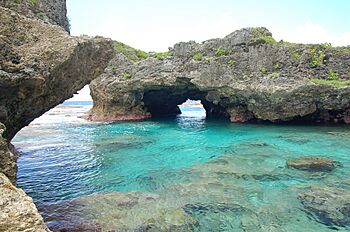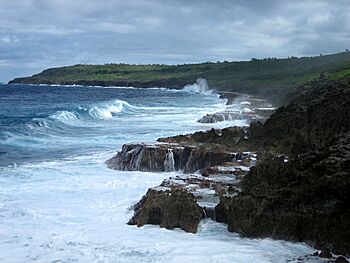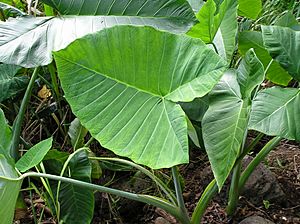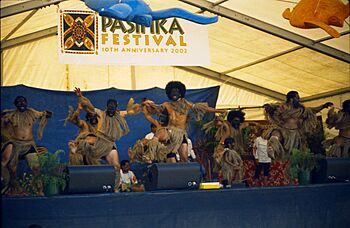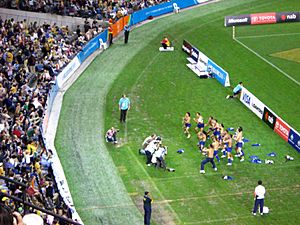Niue facts for kids
Quick facts for kids
Niue
Niuē (Niuean)
|
|
|---|---|
|
Motto: Atua, Niue Tukulagi (Niuean)
"God, Niue Eternally"
|
|
|
Anthem: Ko e Iki he Lagi (Niuean)
"The Lord in Heaven" |
|
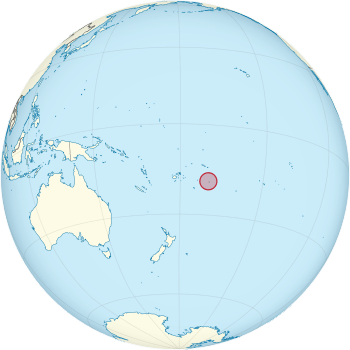 |
|
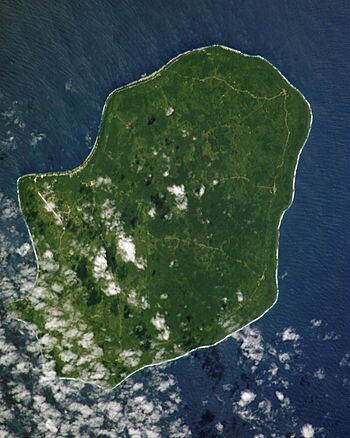
Satellite image of Niue
|
|
| Capital and largest village
|
Alofi 19°03′14″S 169°55′12″W / 19.05389°S 169.92000°W |
| Official languages | |
| Ethnic groups |
|
| Religion |
|
| Demonym(s) | Niuean |
| Government | Unitary non-partisan parliamentary constitutional monarchy |
|
• Monarch
|
Charles III |
| Dame Cindy Kiro | |
|
• Prime Minister
|
Dalton Tagelagi |
| Legislature | Niue Assembly |
| Associated state of New Zealand | |
|
• Self-government in free association with New Zealand
|
19 October 1974 |
|
• Independence in foreign relations recognised by the UN
|
1994 |
| Area | |
|
• Total
|
261.46 km2 (100.95 sq mi) |
|
• Water (%)
|
negligible |
| Population | |
|
• 2018 estimate
|
1,620 (not ranked) |
|
• 2022 census
|
1,681 |
|
• Density
|
[convert: invalid number] (not ranked) |
| GDP (PPP) | 2003 estimate |
|
• Total
|
$10.0 million (228th) |
|
• Per capita
|
$5,800 (164th) |
| GDP (nominal) | 2021 estimate |
|
• Total
|
|
| Currency | New Zealand dollar (NZD) |
| Time zone | UTC−11 |
| Driving side | left |
| Calling code | +683 |
| ISO 3166 code | NU |
| Internet TLD | .nu |
|
|
Niue is a small island country that governs itself, but it works closely with New Zealand. It's located in the South Pacific Ocean and is part of Polynesia. Most of its people are Polynesian. Niue is one of the biggest coral islands in the world. People often call it "The Rock," which comes from its traditional name, "Rock of Polynesia."
Niue is found in a triangle between Tonga, Samoa, and the Cook Islands. It is about 2,400 kilometers (1,500 miles) northeast of New Zealand. The island covers about 261.46 square kilometers (100.95 sq mi). In 2022, its population was 1,689 people.
The island has two main levels. The higher part is a limestone cliff along the coast, with a flat area (plateau) in the middle. This plateau is about 60 meters (200 feet) above sea level. The lower part is a coastal area about 0.5 kilometers (0.3 miles) wide. It slopes down to the sea with small cliffs. A coral reef surrounds the island. The only big opening in the reef is near the capital, Alofi, on the central western coast.
Niue is divided into 14 villages. Each village has a council that chooses its leader. These villages are also like voting areas, and each sends a person to the Niue Assembly (parliament).
Because Niue is part of the Realm of New Zealand, New Zealand handles most of Niue's international relations. People from Niue are citizens of New Zealand. Charles III is Niue's head of state as the King of New Zealand. Most Niuean people (90% to 95%) live in New Zealand. About 70% of people who speak the Niuean language also live there. Niue is a bilingual country, meaning two languages are spoken. About 30% of the people speak both Niuean and English. About 11% speak only English, and 46% speak only Niuean.
Niue has a parliamentary democracy. This means people vote for their leaders. Elections for the parliament happen every three years. Niue is not a member of the United Nations (UN). However, UN groups see it as a self-governing state, similar to an independent country for international law. So, Niue is part of some UN agencies, like UNESCO and the WHO. It is also invited to UN meetings that are open to "all states." Niue has been a member of the Pacific Community since 1980.
Contents
Niue's Past
Polynesians from Samoa first settled in Niue around 900 CE. Later, more settlers arrived from Tonga in the 1500s.
Until the early 1700s, Niue did not have one main government or leader. Chiefs and family heads made decisions for different groups of people. Then, a series of patu-iki (kings) began to rule. The first was Puni-mata. Tui-toga, who ruled from 1875 to 1887, was the first king to become a Christian.
The first Europeans to see Niue were with Captain James Cook in 1774. Cook tried three times to land, but the people living there would not let him. He called the island "Savage Island." Legend says the people who met him had their teeth painted red, which looked like blood. This red color came from a native red fe'i banana called hulahula. For about 200 years, Niue was known as "Savage Island." Later, its original name, "Niue," which means "behold the coconut," was used again.
Whaling ships visited the island often in the 1800s. The first recorded visit was by the Fanny in February 1824. The last known whaler to visit was the Albatross in November 1899.
How Christianity Came to Niue
The next European visitors were from the London Missionary Society. They arrived on the Messenger of Peace. After many years of trying to send a European missionary, they took a Niuean man named Nukai Peniamina. They trained him to be a pastor at the Malua Theological College in Samoa.
Peniamina returned in 1846 on the ship John Williams. He was helped by Toimata Fakafitifonua. He was finally allowed to land in Uluvehi Mutalau after trying in other villages. The chiefs of Mutalau village let him land and protected him at the fort in Fupiu.
Christianity was first taught to the people of Mutalau. Then it spread to all the other villages. At first, other big villages did not want Christianity and tried to harm Peniamina. But the people from Hakupu village later asked for "a word of God." So, their village was renamed "Ha Kupu Atua," meaning "any word of God," or "Hakupu" for short.
In July 1849, Captain John Erskine visited the island on HMS Havannah.
Niue Becomes Part of New Zealand
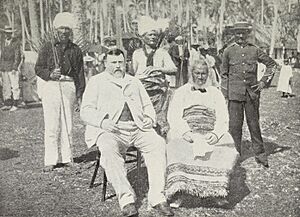
In 1889, the chiefs and rulers of Niue wrote a letter to Queen Victoria. They asked her "to stretch out towards us your mighty hand, that Niue may hide herself in it and be safe." They were worried that another country might take over the island. The letter said, "We leave it with you to do as seems best to you. If you send the flag of Britain that is well; or if you send a Commissioner to reside among us, that will be well." The British did not accept the offer right away. In 1900, people from the Cook Islands asked to be annexed, and they included Niue "if possible."
On October 19, 1900, the King and Chiefs of Niue agreed to "Queen Victoria taking possession of this island." A message to the British government from the Governor of New Zealand mentioned the Chiefs wanting "annexation." It called this document "the deed of cession." A British Protectorate was announced, but it did not last long. Niue became part of New Zealand on June 11, 1901. This happened with the same order that included the Cook Islands.
Niue in Modern Times
Niue International Airport was built in 1970 and started having commercial flights in November 1971.
The New Zealand Parliament gave Niue self-government again with the 1974 Niue Constitution Act. This followed a vote in 1974 where Niueans chose between independence, self-government, or staying a New Zealand territory. Most chose self-government. Niue's written constitution became its main law. Robert Rex, who was part European and part native, was chosen by the Niue Assembly as the first Premier of Niue. He held this job for 18 years until he passed away. In 1984, Rex was the first Niuean to receive a knighthood.
In January 2004, Cyclone Heta hit Niue. It caused a lot of damage across the island, including destroying much of the capital, Alofi. One person died.
On March 7, 2020, Niue became the first entire country to be named an International Dark Sky Sanctuary. This means it protects its night sky from light pollution. On September 29, 2022, President Joe Biden announced that the United States would recognize Niue as a sovereign nation. Diplomatic relations were officially started on September 25, 2023.
Niue's Geography
Niue is a 261.46 square kilometer (100.95 sq mi) raised coral atoll in the southern Pacific Ocean, east of Tonga. There are three other coral reefs in Niue's special ocean area, but they don't have any land.
Niue is one of the world's largest coral islands. Its land has steep limestone cliffs along the coast. In the middle, there is a flat area (plateau) that rises to about 60 meters (200 feet) above sea level. A coral reef goes all around the island. The only big opening in the reef is on the central western coast, near the capital, Alofi. There are also many limestone caves near the coast.
The island is shaped like an oval, about 18 kilometers (11 miles) across. There are two large bays on the western coast: Alofi Bay in the center and Avatele Bay in the south. Most of the people live near the west coast, around the capital, and in the northwest.
Niue's Climate
Niue has a tropical rainforest climate. This means it has high temperatures and a lot of rain all year. While there isn't a true wet or dry season, it rains more from October to May.
Protecting Niue's Environment
Niue is working to become a "green growth" country. The Niue Island Organic Farmers Association is trying to make Niue the world's first fully organic nation.
Even though Niue has a small population, it is working to use more renewable energy. In July 2009, a solar panel system was put in place. This system adds about 50 kilowatts of power to Niue's electricity grid. More solar power stations were added in 2014.
In 2023, Niue and other island countries launched a plan called the "Port Vila Call for a Just Transition to a Fossil Fuel Free Pacific." They are asking for a stop to fossil fuels and a quick move to renewable energy. They also want stronger environmental laws.
In 2022, Niue declared its entire special ocean area (EEZ) to be a marine park. This helps protect the ocean and its creatures.
Niue's Plants and Animals
Niue is part of the Tongan tropical moist forests area. The island has about 60 types of plants that are native or were there before Europeans arrived. It also has about 160 types of flowering plants that have become naturalized.
The Huvalu Forest Conservation Area is a large protected area of 5,400 hectares (20 sq mi) on the eastern side of the island. It was created in 1992. This area protects the biggest part of Niue's original forest. It is also an Important Bird Area because it is home to birds like crimson-crowned fruit doves, blue-crowned lorikeets, Polynesian trillers, and Polynesian starlings.
Niue's Government and Politics
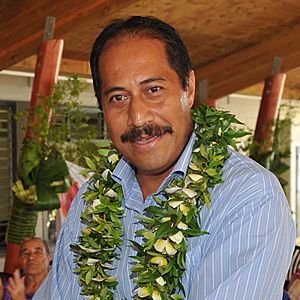
The Niue Constitution Act of 1974 gives power to His Majesty the King in Right of New Zealand and the Governor-General of New Zealand. However, in daily life, the government is run by the Cabinet. The Cabinet includes the Prime Minister (currently Dalton Tagelagi since June 11, 2020) and three other ministers. The Prime Minister and ministers are all members of the Niue Assembly, which is the country's parliament.
The Assembly has 20 members. Fourteen members are chosen by voters in each village. Six members are chosen by all registered voters across the island. To vote, you must be a New Zealand citizen and have lived in Niue for at least three months. To be a candidate, you must be a voter and have lived in Niue for 12 months. Everyone born in Niue must register to vote.
Niue does not have political parties. All members of the Assembly are independent. The only political party Niue ever had was the Niue People's Party (1987–2003). It won once in 2002 before it stopped existing the next year.
The Legislative Assembly chooses a Speaker as its first leader after an election. The Speaker asks for people to be nominated for prime minister. The person with the most votes from the 20 members is chosen. The prime minister then picks three other members to form the Cabinet, which is the part of the government that carries out laws. General elections happen every three years. The most recent one was on April 29, 2023.
The courts in Niue are separate from the government leaders and lawmakers. They include a High Court and a Court of Appeal. People can appeal decisions to the Judicial Committee of the Privy Council in London.
Niue's Foreign Relations and Defence
Niue has been a self-governing state working closely with New Zealand since September 3, 1974. This is when the people voted for their Constitution. Niue is fully in charge of its own matters inside the country.
At first, New Zealand was responsible for Niue's foreign relations and defence. However, Niue has slowly started to build its own relationships with other countries. It is a member of the Pacific Islands Forum and many other regional and international groups. Niue is not a member of the United Nations, but it is part of several important international agreements. For example, it joined UNESCO on October 26, 1993. It also started diplomatic relations with China on December 12, 2007, and with India on August 30, 2012. On June 10, 2014, Niue also started diplomatic relations with Turkey.
People from Niue have fought as part of the New Zealand military. During World War I (1914–1918), about 200 Niuean soldiers joined the New Zealand (Māori) Pioneer Battalion.
Niue does not have its own regular military. New Zealand is responsible for Niue's defence. The New Zealand Defence Force protects Niue's land and its special ocean area (EEZ), which is about 317,500 square kilometers (122,588 sq mi). Ships from the Royal New Zealand Navy and planes from the Royal New Zealand Air Force help with this. New Zealand forces also provide other help and support for Niue.
Niue's Economy
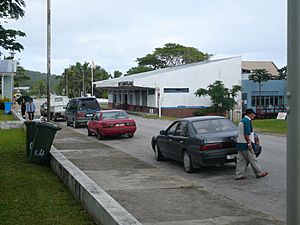
Niue uses the New Zealand dollar as its money. In 2016, Niue's total economic output (GDP) was about US$24.9 million.
The Niue Integrated Strategic Plan (NISP) is the country's plan for development. It sets goals for how Niue will grow. When Cyclone Heta hit in early 2004, it caused a lot of damage. This set back Niue's plans for about two years because everyone focused on recovery. After the cyclone, the government worked hard to help businesses recover. In 2004, New Zealand gave $1 million to help businesses and build the Fonuakula Industrial Park. This park is now finished, and some businesses are working there. The Niue Chamber of Commerce manages the park and helps businesses.
Farming and Fishing
The government and a New Zealand company called Reef Group started two joint projects in 2003 and 2004. One was to develop fishing, and the other was for a large noni juice operation. Noni fruit comes from a small tree with edible fruit. Niue Fish Processors Ltd (NFP) is a company that processes fresh fish, mostly tuna, to sell to other countries.
Trade
Niue is working on trade agreements with other Pacific countries and with the European Union, Australia, and New Zealand.
Money and Aid
Money sent home by Niueans living in other countries used to be a big source of income in the 1970s and early 1980s. But now, many families have moved to New Zealand, so less money is sent back to Niue.
Money from other countries (foreign aid) is a very important source of income. It makes up about one-third of Niue's government money each year. Most of this aid comes from New Zealand, which has a legal duty to help Niue. Other ways the government gets money are from taxes and things like selling special stamps and leasing phone lines.
In 2016, Niue announced that it had paid off all its national debt. The government planned to use the money saved to increase pensions and encourage Niueans living abroad to return home. However, Niue still relies on New Zealand for economic support, receiving about $14 million in aid each year.
Internet in Niue
In 2003, Niue became the first country in the world to provide free wireless internet to everyone.
In August 2008, all school students received special laptops called OLPC XO-1s. These laptops are designed for children in developing countries. Niue was also a testing place for a project that aims to create low-cost mobile phone towers using open-source software.
In July 2011, Telecom Niue started offering pre-paid mobile phone services. In January 2015, Telecom Niue finished laying a fiber optic cable around the island. This connected all 14 villages, making landline phones and ADSL internet available to homes.
Niue was connected to the Manatua Fibre Cable in 2021, which improved its internet connection even more.
Farming in Niue
Farming is very important to the way of life and economy in Niue. About 204 square kilometers (79 sq mi) of land can be used for farming. Most households grow taro for their own food. Taro is a main food, and the pink taro that is popular in New Zealand and Australia comes from Niue. This type of taro grows naturally in Niue and is strong against pests. Niue exports taro to New Zealand.
Other crops like tapioca (cassava), yams, and kumara also grow well, as do different types of bananas. In the 1970s, copra (dried coconut meat), passionfruit, and limes were the main exports. But in 2008, vanilla, noni, and taro were the main crops sold to other countries.
Most families grow their own food and sell any extra at the Niue Makete in Alofi or send it to New Zealand. Coconut crab, or uga, is also part of the food eaten in Niue. It lives in the forest and coastal areas.
In 2003, the government decided to grow and sell more vanilla with help from NZAID. Vanilla has grown wild on Niue for a long time. The vanilla industry was badly damaged by Cyclone Heta in early 2004, but it has since recovered.
Tourism in Niue
Tourism is one of the three main areas for economic growth, along with fishing and farming. In 2006, visitors spent about US$1.6 million. The only airport is Niue International Airport. Air New Zealand is the only airline, flying twice a week from Auckland.
The sailing season starts in May. Alofi Bay has many places for boats to anchor. Niue is trying to get foreign investors to put money into tourism. They offer tax breaks to encourage this.
Niue as a Dark-Sky Nation
Niue became the world's first dark-sky country in March 2020. The whole island works to keep light pollution low. Guided tours to see the stars are offered to tourists, led by trained Niuean community members.
Niue's People
The following information about Niue's population comes from official records.
Population Numbers
| Year | Population |
|---|---|
| 1900 | 4,015 |
| 1921 | 3,750 |
| 1945 | 4,253 |
| 1966 | 5,194 |
| 1974 | 3,992 |
| 1986 | 2,531 |
| 1996 | 2,089 |
| 2006 | 1,625 |
| 2017 | 1,719 |
| 2022 | 1,681 |
Who Lives in Niue
- Niuean: 65.4%
- Part-Niuean: 14%
- Non-Niuean: 20.6% (This includes 14% from other Pacific Islands and 6.6% others, like Europeans and Asians.)
Religions in Niue
Based on the 2022 Census:
- Ekalesia Niue (Congregational Christian Church of Niue – a Protestant church): 61%
- Church of Jesus Christ of Latter-day Saints: 9%
- Catholic: 7%
- Seventh-day Adventist: 3%
- Jehovah's Witnesses: 2%
- Other: 3%
- None: 7%
Languages Spoken
- Niuean (official; a Polynesian language like Tongan): 46%
- Niuean and English: 32%
- English (official): 11%
- Niuean and other languages: 5%
- Other languages: 6%
Niue's Culture
John Pule, a New Zealand artist and writer, was born in Niue. He wrote The Shark That Ate the Sun. He also paints designs inspired by tapa cloth on canvas. In 2005, he helped write Hiapo: Past and Present in Niuean Barkcloth, which is a book about a traditional Niuean art form. Matafetu Smith started the first Niuean women's weaving group in Auckland.
Taoga Niue is a government department that works to protect Niue's culture, traditions, and heritage. The government sees this as very important.
Media in Niue
Niue has two TV and radio stations: Television Niue and Radio Sunshine. These are run by the Broadcasting Corporation of Niue. There is also one newspaper, the Niue Star.
Arts and Culture
Hiapo is a traditional art form in Niue. It is similar to Siapo or Ngatu Tonga. Hiapo is made by beating the inner bark of the paper mulberry tree until it becomes a soft tapa cloth. This cloth is then decorated using natural dyes and stencils. Some Niuean hiapo artists include John Pule and Cora-Allan Wickliffe.
Niue is also known for the takalo, which is a war dance. It was traditionally performed before battles. Today, it is used for special events like birthdays, funerals, and important celebrations. People performing the takalo usually wear traditional costumes.
Museums
In 2004, Cyclone Heta destroyed the Huanaki Cultural Centre & Museum. The buildings were ruined, and over 90% of the museum's collections were lost. In 2018, the Fale Tau Tāoga Museum opened. This is Niue's new national museum.
Food in Niue
Because of where the island is and the many fruits and vegetables grown there, local produce and fresh seafood are important in Niuean dishes. Takihi, the national dish, is made from coconut cream and thin slices of taro and papaya. These are layered to form a cake-like dish. Traditionally, it is wrapped in taro leaves and cooked in an Umu (earth oven). Today, people often cook takihi in their home ovens.
Sports in Niue
Even though Niue is a small country, many sports are popular. Rugby union is the most popular sport for both men and women. Niue was the champion of the 2008 FORU Oceania Cup. Netball is played only by women. There is a nine-hole golf course at Fonuakula and a single lawn bowling green. Association football is also popular, as seen by the Niue Soccer Tournament. Rugby league is another popular sport.
Niue takes part in the Commonwealth Games. However, unlike the Cook Islands, it is not a member of the International Olympic Committee (IOC). This means it does not compete in the Olympic Games. To be in the Olympics, a country must be an "independent State recognized by the international community."
Images for kids
See also
 In Spanish: Niue para niños
In Spanish: Niue para niños






